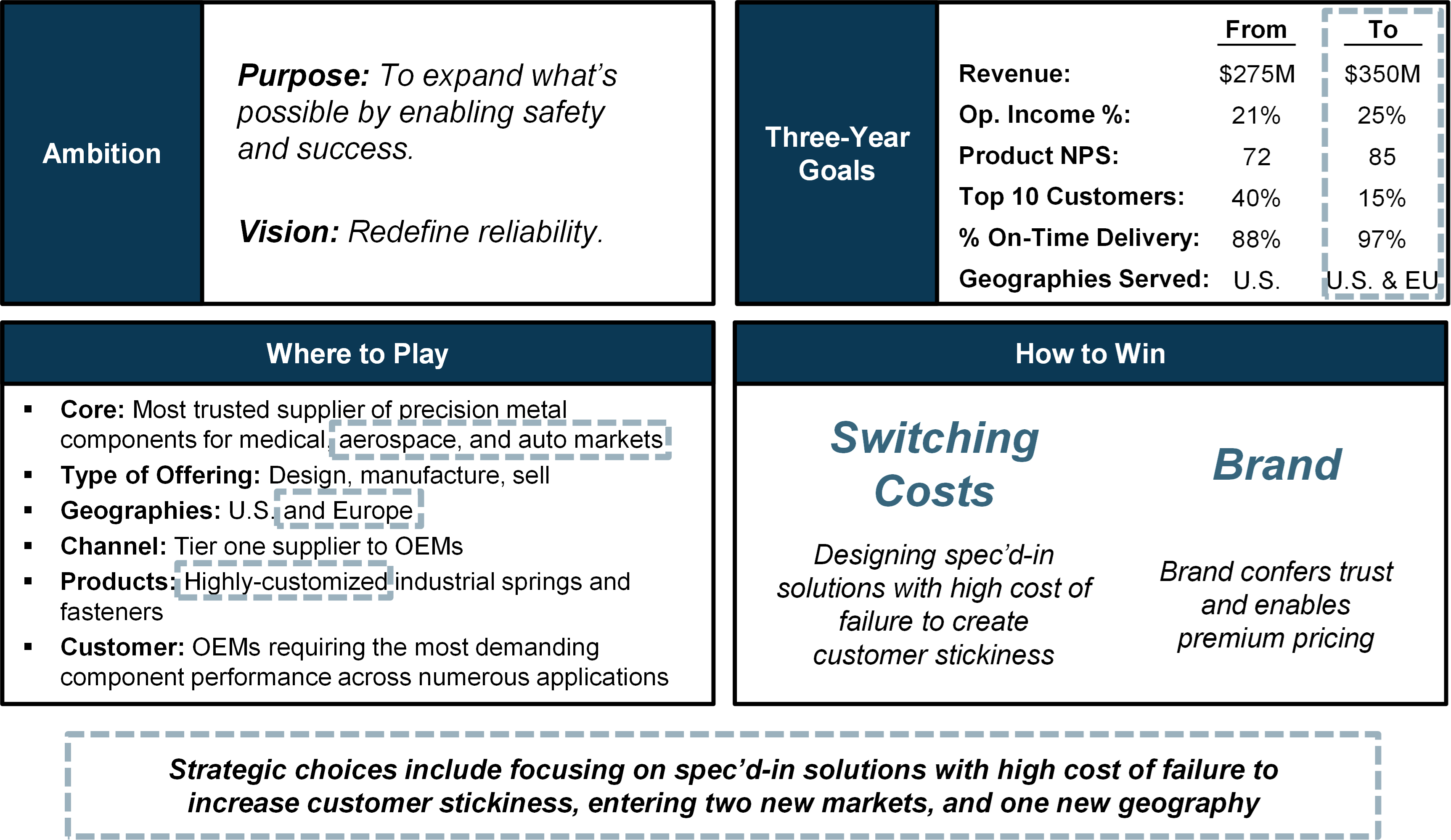Strategy: Three Questions (Part 2)
BY KANBRICK
Where are We Going?
In Part 2 of our strategy series, we answer the question of “Where are We Going”. Building on the starting point of “Where are we Today”, we seek to define our strategic vision and options. We like the “Where to play” and “How to win” framework for assessing strategic options. It clearly defines where you compete (and just as importantly what you won’t do) and how you expect to win in this market (e.g., leveraging sources of competitive advantage).
Where to Play?
Where-to-play defines the focus areas for the business. Although certain where-to-play choices may feel inherent to your business, it is an opportunity to step back and assess these fundamental choices (e.g., Polaroid and Blockbuster both could have better incorporated digital into their strategic choices) and also ensure organizational alignment on the key priorities. Where-to-play options exist across a number of dimensions including:
- Core Business: Define your organization’s core business
- Geography: Where you compete (e.g., North America)
- Channel: How your good or service reaches the consumer (e.g., direct sales force, website, etc.)
- Product / Service: What you sell
- Customer: Who is your target customer
- Value Chain: Where you play in value chain (e.g., manufacturer vs. distributor)
A key part of the process involves determining how these choices should evolve over time – e.g., expanding geographies from North America to Europe, entering new product categories, or exiting a non-core part of the business.
How to Win?
How-to-win defines your recipe for success in your chosen markets – markets are competitive, and it is important to have a view on how you will “win” to create value. There are two key components to how-to-win: (1) value proposition and (2) competitive advantage. The value proposition defines why customers purchase from you (e.g., low cost, high quality, speed of delivery, etc.) , and your competitive advantage is what keeps other well financed competitors from encroaching on your turf (and eroding your margins, earnings, returns on capital, etc.). Warren Buffet has famously called these “moats”, and we like Pat Dorsey’s framework that breaks moats into four categories:
- Switching Costs: The cost (e.g., dollars, time, risk, etc.) of switching to a new provider creates customer stickiness. For example, enterprise software often is a small fraction of a company’s overall budget, but it is expensive and risky to change.
- Intangible Assets: Brands, patents, or licenses that increase willingness to pay or reduce search costs. Within brands, advantages can include search costs (e.g., Coca-Cola), positional value (e.g., Tiffany), or trust (e.g., large accounting firms).
- Cost Advantages: Advantages are derived from lower costs via process, scale, niche market structure, or location. For example, a marble quarry next to major customers will inherently have a cost advantage vs. a similar quarry 500 miles away.
- Network Effects: The value of the network increases as the user base grows. For example, the more people that use Facebook, the more the utility becomes for each user because there are more to connect and share with.
A strong moat is rare and supports value creation by enabling a business to generate above average cash flow and returns on capital. For example, Microsoft is able to earn attractive returns via the switching cost advantage driven by its software (e.g., Microsoft Office), which locks in customers by making their work less compatible and transferrable to other programs thus creating difficulty for new challengers to compete. Many businesses lack a clear moat, and the strategy process provides an opportunity to either build a moat (e.g., invest in a differentiated brand or create products with higher switching costs) or to focus on operational excellence, which involves constantly improving costs and product performance to keep your competition at bay. If your business possesses a moat, concentrate your strategic options on widening it. In the crucible of capitalism, which is like rapid-paced natural selection for companies, moats are either growing a bit wider or shrinking a bit narrower every day. Be mindful of the fact that every strategic option that doesn’t directly strengthen your moat weakens it.
Where-to-play and how-to-win is the one-two punch at the heart of strategy. Good answers to these questions do not function independently – a where-to-play option is only valuable if its how-to-win is closely linked and supportive. We recommend developing multiple sets of where-to-play and how-to-win alternatives and selecting the best option for the organization.
Vision & 3-Year Goals
The last component of “Where are we going?” is to craft a vision and define the 3-year goals of the organization. A shared vision sets a finish line that will require extraordinary organizational effort and alignment to cross. It should be challenging, yet achievable; but only by building your business around explicit where-to-play and how-to-win choices. After all, strategy is choice – deliberately doing some things and not doing others – and while choosing is hard and confines you to a particular path, it also frees you to unleash your time, talent, and energy on the handful of areas that really matter.
To help bring this to life, we’ve created an example. The below exhibit presents an illustrative answer to “Where are we going?” for a mid-sized manufacturer of industrial springs and fasteners serving the medical market. After performing a diagnostic and reviewing its strategic options, the company’s leadership identified attractive moats in the areas of switching costs and brand that support a strategic shift toward made-to-order solutions (instead of more commoditized made-to-stock products) in multiple adjacent markets:

SHARE:
